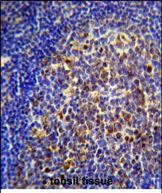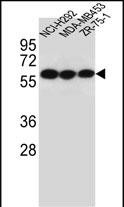CHRNA10 Antibody (Center)
Affinity Purified Rabbit Polyclonal Antibody (Pab)
- 产品详情
- 实验流程
- 背景知识
Application
| IHC-P, WB, E |
|---|---|
| Primary Accession | Q9GZZ6 |
| Other Accession | Q9JLB5, NP_065135.2 |
| Reactivity | Human |
| Predicted | Rat |
| Host | Rabbit |
| Clonality | Polyclonal |
| Isotype | Rabbit IgG |
| Calculated MW | 49705 Da |
| Antigen Region | 179-206 aa |
| Gene ID | 57053 |
|---|---|
| Other Names | Neuronal acetylcholine receptor subunit alpha-10, Nicotinic acetylcholine receptor subunit alpha-10, NACHR alpha-10, CHRNA10, NACHRA10 |
| Target/Specificity | This CHRNA10 antibody is generated from rabbits immunized with a KLH conjugated synthetic peptide between 179-206 amino acids from the Central region of human CHRNA10. |
| Dilution | IHC-P~~1:100~500 WB~~1:1000 E~~Use at an assay dependent concentration. |
| Format | Purified polyclonal antibody supplied in PBS with 0.09% (W/V) sodium azide. This antibody is purified through a protein A column, followed by peptide affinity purification. |
| Storage | Maintain refrigerated at 2-8°C for up to 2 weeks. For long term storage store at -20°C in small aliquots to prevent freeze-thaw cycles. |
| Precautions | CHRNA10 Antibody (Center) is for research use only and not for use in diagnostic or therapeutic procedures. |
| Name | CHRNA10 (HGNC:13800) |
|---|---|
| Synonyms | NACHRA10 |
| Function | Component of neuronal acetylcholine receptors (nAChRs) that function as pentameric, ligand-gated cation channels with high calcium permeability. nAChRs are excitatory neurotrasnmitter receptors formed by a collection of nAChR subunits. Each nAchR subunit confers differential attributes to channel properties, including activation, deactivation and desensitization kinetics, pH sensitivity, cation permeability, and binding to allosteric modulators (Probable). Forms heteropentamers with CHRNA9. Expressed in the inner ear, in sympathetic neurons and in other non-neuronal cells, such as skin keratinocytes and lymphocytes (PubMed:11752216, PubMed:15531379). nAChR formed by CHRNA9:CHRNA10 is involved in modulation of auditory stimuli. The channel is permeable to a range of divalent cations including calcium, the influx of which may activate a potassium current which hyperpolarizes the cell membrane. In the ear, mediates synaptic transmission between efferent olivocochlear fibers and hair cells of the cochlea, this may lead to a reduction in basilar membrane motion, altering the activity of auditory nerve fibers and reducing the range of dynamic hearing (PubMed:11752216). This may protect against acoustic trauma. May also regulate keratinocyte adhesion (By similarity). |
| Cellular Location | Synaptic cell membrane {ECO:0000250|UniProtKB:Q9JLB5}; Multi-pass membrane protein. Cell membrane {ECO:0000250|UniProtKB:Q9JLB5}; Multi-pass membrane protein |
| Tissue Location | Expressed in inner-ear tissue, tonsil, immortalized B-cells, cultured T-cells and peripheral blood lymphocytes |
For Research Use Only. Not For Use In Diagnostic Procedures.
Provided below are standard protocols that you may find useful for product applications.
BACKGROUND
CHRNA10 is an ionotropic receptor with a probable role in the modulation of auditory stimuli. Agonist binding may induce an extensive change in conformation that affects all subunits and leads to opening of an ion-conducting channel across the plasma membrane. The channel is permeable to a range of divalent cations including calcium, the influx of which may activate a potassium current which hyperpolarizes the cell membrane. In the ear, this may lead to a reduction in basilar membrane motion, altering the activity of auditory nerve fibers and reducing the range of dynamic hearing. This may protect against acoustic trauma.
REFERENCES
Saccone, N.L., et al. Genes Brain Behav. 9(7):741-750(2010)
Rose, J.E., et al. Mol. Med. 16 (7-8), 247-253 (2010) :
Rigbi, A., et al. Pharmacogenomics J. (2010) In press :
Need, A.C., et al. Eur. J. Hum. Genet. 17(7):946-957(2009)
Saccone, N.L., et al. Am. J. Med. Genet. B Neuropsychiatr. Genet. 150B (4), 453-466 (2009) :
终于等到您。ABCEPTA(百远生物)抗体产品。
点击下方“我要评价 ”按钮提交您的反馈信息,您的反馈和评价是我们最宝贵的财富之一,
我们将在1-3个工作日内处理您的反馈信息。
如有疑问,联系:0512-88856768 tech-china@abcepta.com.























 癌症的基本特征包括细胞增殖、血管生成、迁移、凋亡逃避机制和细胞永生等。找到癌症发生过程中这些通路的关键标记物和对应的抗体用于检测至关重要。
癌症的基本特征包括细胞增殖、血管生成、迁移、凋亡逃避机制和细胞永生等。找到癌症发生过程中这些通路的关键标记物和对应的抗体用于检测至关重要。 为您推荐一个泛素化位点预测神器——泛素化分析工具,可以为您的蛋白的泛素化位点作出预测和评分。
为您推荐一个泛素化位点预测神器——泛素化分析工具,可以为您的蛋白的泛素化位点作出预测和评分。 细胞自噬受体图形绘图工具为你的蛋白的细胞受体结合位点作出预测和评分,识别结合到自噬通路中的蛋白是非常重要的,便于让我们理解自噬在正常生理、病理过程中的作用,如发育、细胞分化、神经退化性疾病、压力条件下、感染和癌症。
细胞自噬受体图形绘图工具为你的蛋白的细胞受体结合位点作出预测和评分,识别结合到自噬通路中的蛋白是非常重要的,便于让我们理解自噬在正常生理、病理过程中的作用,如发育、细胞分化、神经退化性疾病、压力条件下、感染和癌症。







